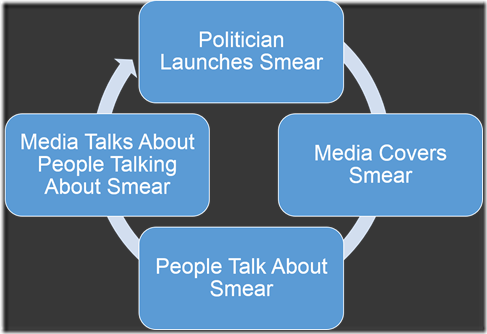The Smear Cycle: Hillary Clinton May Have Brain Damage
Karl Rove, the former top advisor to President Bush, launched a new smear campaign against Hillary Clinton late last week. Speaking at a conference, Rove brought up Clinton’s 2012 health scare, during which she spent several days in a hospital. From The New York Post:
“Thirty days in the hospital?” Rove said, according to Page Six. “And when she reappears, she’s wearing glasses that are only for people who have traumatic brain injury? We need to know what’s up with that.”
The headline of that piece, “Karl Rove: Hillary May Have Brain Damage,” was exactly what Rove sought. That headline triggered many others (American Thinker went with “Might Hillary Clinton Have Suffered a Stroke?”), and forced the story into the mainstream media. Suddenly, outlets including The Washington Post, Politico, Fox News, and MSNBC were talking about Mrs. Clinton’s health.
Here are some facts: Hillary Clinton was not in the hospital for thirty days; she was in the hospital for four, and physicians anticipated a recovery with “no long-term consequences.”
To be clear, there are legitimate questions about Clinton’s health and age. Similar questions have been posed about Ronald Reagan, Bob Dole, and John McCain (among others), and it isn’t sexist or ageist to pose such questions.
But Rove’s smear wasn’t a genuine attempt to raise questions about Clinton’s fitness for office. It was a classic Lee Atwater-like tactic intended to damage his party’s most likely opponent. (Atwater, also a former Republican strategist, repented for his brand of scorched-earth politics on his death bed.)
True to the tactic, Rove quickly backed away from his statement and dissembled, claiming he never used the term “brain damage.” (That’s true; he said “traumatic brain injury,” which conveys the same message.) There’s no need for the person who launched the gossip cycle to defend it once people are already talking about it; he can walk away, pretending his hands are clean, while others carry the message for him.
Hillary Clinton’s Team Did Something Similar
In 2008, Hillary Clinton’s Senior Campaign Strategist, Mark Penn, appeared on Hardball and repeatedly mentioned the fact that Barack Obama had used cocaine—and he did it in that sleazy political way of pretending that he wasn’t talking about that issue:
“We’ve made clear that the [unintelligible] related to cocaine use is not something that the campaign was in any way raising.”
Catch that? Penn simultaneously raised the issue of cocaine use, which helped it remain a media story, while disingenuously pretending that his campaign didn’t want to talk about it. (It wasn’t the first time a Clinton confidante employed that strategy; Clinton later apologized.) Joe Trippi, John Edwards’s senior strategist who appeared on Hardball next to Penn, confronted Penn for using that tactic.
(Exchange begins at 3:54)
The Smear Cycle
This tactic is used by politicians on both sides of the aisle, and it’s often effective. The smear cycle looks something like this:
That cycle is unlikely to change. But at least we can diminish its power by recognizing when it’s unfolding before us.
Don’t miss a thing! Click here to receive our most popular posts once each week.






I feel that your headline adds to the smear, since some people may just read “Hillary Clinton has brain damage” and thus it stays in the public mind.
Deborah,
Thank you for your comment. I shared a similar concern, and labored over that headline for a while for exactly that reason. I felt that preceding it with “The Smear Cycle” made clear that there was more to the headline than it appeared. I hope most people took it that way.
Honest question: Given the space limitations involved, how would you have titled the post?
Thanks,
Brad
Hey Brad! Hope all is well.
I know this is an older post; but as I do play with words these days ;), I couldn’t resist your question. How about, “The Smear Cycle: Let’s (not) Talk about Hillary’s Brain” or something employing a similar nod and wink approach. That would allow you to make your point while not proliferating this particular instance.
Great post, by the way. I find the smear to be nearly as irritating as the non-apology apology.
Hey John,
Thanks for your idea! I like your headline – it serves the purpose of being both compelling and accurate. In moments like these, I understand the value of focus-grouping titles (which, when writing a daily blog, is realistically close to impossible).
Thanks, as always, for reading.
Brad